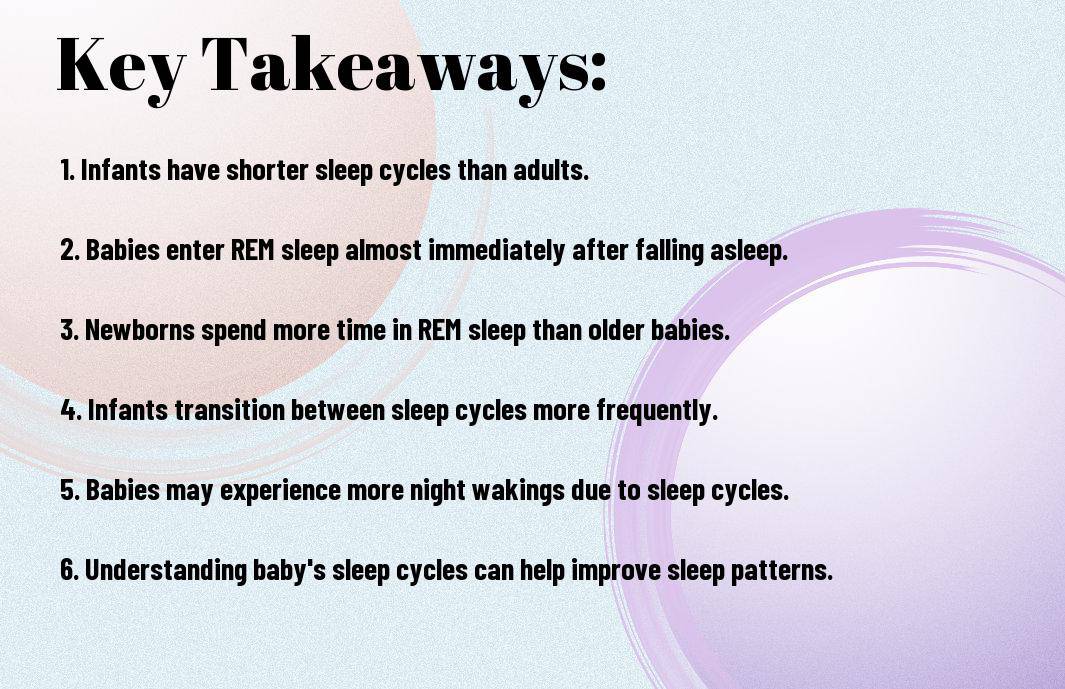tips, tricks and guides for parenthood
Understanding the intricacies of infant sleep cycles can greatly benefit parents in ensuring the well-being and healthy development of their little ones. Infants have unique sleep patterns that differ from adults, revolving around rapid eye movement (REM) and non-rapid eye movement (NREM) phases. Unravelling the mysteries of these cycles can shed light on how babies sleep, helping caregivers create optimal sleep environments and schedules. Join us as we explore into the world of infant sleep cycles to gain a deeper insight into how these tiny wonders rest and grow.

Infant sleep is divided into two main stages: REM (rapid eye movement) sleep and non-REM sleep. During REM sleep, infants may twitch, smile, and even cry, while non-REM sleep is a deeper, more restful state. These stages alternate throughout the night, with infants spending more time in REM sleep compared to adults.
When comparing infant sleep cycles to those of adults, there are notable differences. Infants have shorter sleep cycles, typically lasting around 50-60 minutes, compared to adults' 90-minute cycles. Additionally, infants spend more time in REM sleep, which is crucial for brain development and learning. This emphasis on REM sleep decreases as we age.
| Infant Sleep Cycles | Adult Sleep Cycles |
| Shorter cycles (50-60 mins) | Longer cycles (90 mins) |
| More time in REM sleep | Less time in REM sleep |
Infant sleep is heavily influenced by developmental milestones such as rolling over, sitting up, and crawling. These new skills can disrupt sleep patterns as babies practice them during the day and even in their sleep. To learn more about how these milestones impact sleep, check out Baby Sleep Cycles & Patterns Explained.
Environmental factors like room temperature, noise levels, and lighting, as well as dietary factors such as feeding schedules and types of food, can play a significant role in an infant's sleep. It's crucial to create a comfortable and quiet sleep environment for your baby and establish a consistent bedtime routine. Implementing healthy feeding habits can also help regulate sleep patterns. Knowing how these factors affect sleep can aid in developing better sleeping habits for your baby.
Knowing these environmental and dietary factors can assist parents in creating an optimal sleep environment for their little ones, promoting healthier sleep habits in infants.
Creating a consistent bedtime routine is crucial for helping your infant develop healthy sleep habits. This routine could include activities like bathing, reading a bedtime story, and dimming the lights to signal that it's time to sleep. By following the same routine each night, your baby will learn to associate these activities with bedtime, making it easier for them to settle down and fall asleep.
Ensuring your baby sleeps safely is necessary to reduce the risk of Sudden Infant Death Syndrome (SIDS). Always place your baby on their back to sleep, use a firm mattress with a fitted sheet, and avoid having soft bedding, toys, or loose blankets in the crib. The sleep environment should be kept at a comfortable temperature, and it's advisable to avoid co-sleeping with your baby, especially on soft surfaces like sofas or armchairs.
Infant sleep cycles are crucial for their growth and development, consisting of alternating between light sleep, deep sleep, and REM sleep. Understanding these sleep patterns can help parents create a conducive environment for their babies to get adequate rest. By recognising the signs of tiredness, establishing a bedtime routine, and providing a safe sleeping environment, parents can support their infants in getting the quality sleep they need. It is crucial to remember that each baby is unique, and their sleep patterns may vary. By being patient, observant, and responsive to their individual needs, parents can help their infants establish healthy sleep habits that will benefit them in the long run.
A: Infant sleep cycles refer to the patterns of sleep and wakefulness that babies go through during their sleep. These cycles are crucial for their development and wellbeing.
A: An infant's sleep cycle typically lasts around 50-60 minutes in the first few months of life. As they grow older, the duration of each sleep cycle may lengthen.
A: Infants can go through 4-6 sleep cycles in a night, depending on their age and development stage. Each cycle consists of both light and deep sleep stages.
A: Understanding infant sleep cycles can help parents and caregivers create a conducive sleep environment, establish healthy sleep habits, and ensure that babies get the restorative sleep they need for growth and development.
A: Parents can support healthy sleep cycles in infants by establishing a consistent bedtime routine, creating a calm sleep environment, responding to baby's cues promptly, and ensuring that the sleeping environment is safe and comfortable. Consulting with a healthcare provider for any sleep concerns is also recommended.